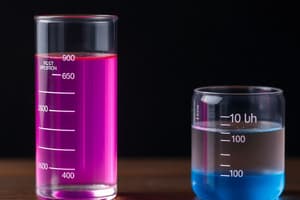Podcast
Questions and Answers
What type of solution is characterized by containing less solute than a saturated solution at a given temperature and pressure?
What type of solution is characterized by containing less solute than a saturated solution at a given temperature and pressure?
- Unsaturated solution (correct)
- Supersaturated solution
- Hypersaturated solution
- Saturated solution
In a 30% sugar solution in water, how many grams of water are present in 100 grams of the solution?
In a 30% sugar solution in water, how many grams of water are present in 100 grams of the solution?
- 70 grams (correct)
- 30 grams
- 100 grams
- 40 grams
Which factor affecting solubility involves the nature of the solute and solvent?
Which factor affecting solubility involves the nature of the solute and solvent?
- Surface area
- Pressure
- Stirring
- Temperature (correct)
What concentration unit is computed by dividing the mass of the solute by the mass of the solution?
What concentration unit is computed by dividing the mass of the solute by the mass of the solution?
Which type of solution is unstable and has a solute concentration higher than in a saturated solution?
Which type of solution is unstable and has a solute concentration higher than in a saturated solution?
If a solution contains the maximum amount of solvent at a constant temperature and pressure, what type of solution is it?
If a solution contains the maximum amount of solvent at a constant temperature and pressure, what type of solution is it?
What is the expression of molarity in terms of units?
What is the expression of molarity in terms of units?
If 1 gram of a solute is dissolved in 1,000 grams of solvent, what is the concentration in parts per million (PPM)?
If 1 gram of a solute is dissolved in 1,000 grams of solvent, what is the concentration in parts per million (PPM)?
What is the relationship between molar mass and formula weight of elements in a compound?
What is the relationship between molar mass and formula weight of elements in a compound?
Which concentration unit expresses the number of moles of solute in one kilogram of solvent?
Which concentration unit expresses the number of moles of solute in one kilogram of solvent?
If a solute is present at 1 μg/L, what is the concentration expressed in parts per billion (PPB)?
If a solute is present at 1 μg/L, what is the concentration expressed in parts per billion (PPB)?
Which concentration unit divides the number of moles of solute by 1 kg of solvent?
Which concentration unit divides the number of moles of solute by 1 kg of solvent?
What is the unit of molality?
What is the unit of molality?
Which concentration unit should be used for calculations performed over different temperatures?
Which concentration unit should be used for calculations performed over different temperatures?
What does mole fraction measure?
What does mole fraction measure?
What is the sum of the mole fractions of each component in a solution?
What is the sum of the mole fractions of each component in a solution?
What is the concept known as titration also called?
What is the concept known as titration also called?
Flashcards are hidden until you start studying
Study Notes
Types of Solutions
- Unsaturation: a solution that contains less solute than a saturated solution at a given temperature and pressure.
- Saturation: a solution that contains the maximum amount of solute at a constant temperature and pressure.
- Supersaturation: an unstable solution where the concentration of the solute is greater than when the solution is saturated.
Factors Affecting Solubility
- The nature of solute and solvent
- Temperature
- Pressure
- Surface area
- Stirring
Concentration of Solutions
- Refers to the amount or quantity of solute present in a specified amount of solvent
- Methods of expressing concentration: percent by mass (%), molality (m), mole fraction (x), and parts per million (ppm), parts per billion (ppb), and parts per trillion (ppt)
Percent by Mass (%)
- Computed by dividing the mass of the solute by the mass of the solution
- Example: 30% sugar solution in water means 30 grams of sugar is dissolved in 70 grams of water to create 100 grams of solution
Molality (m)
- Similar to molarity except that the number of moles of solute is divided by 1 kg of solvent rather than 1 L of solution
- Unit of molality is M, read as molal
Mole Fraction (x)
- Defined as the amount of the component of the solution expressed in moles per mole of solution
- The sum of the mole fractions of each component of the solution is always equal to 1
Properties of Solutions (Part II)
- Haber Process: an industrial process for producing ammonia from nitrogen and hydrogen using an iron catalyst at high temperature and pressure
Titration (Titrimetry)
- A method of expressing concentration in terms of volume used when the substances that form the solution are in states whose quantities can be more accurately measured in terms of volume
Molar Mass
- A mole is the SI unit of number of particles and can be used as an expression of the molecular weight of a substance
- The formula weight of an element is expressed as grams/mole
- The molar mass of a compound can be calculated by adding the molar mass of the individual elements
Molarity
- Defined as the number of moles of solute in one liter of solution
- Denoted as M and has the unit of mol/L
- Read as molar
Studying That Suits You
Use AI to generate personalized quizzes and flashcards to suit your learning preferences.




